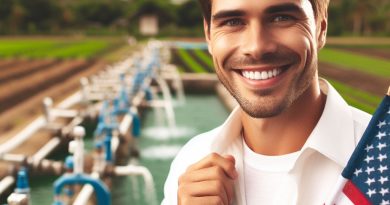Climate Impact: Soil Salinity and Solutions
Last Updated on March 2, 2024
Introduction
Understanding the climate impact of soil salinity and implementing effective solutions is crucial for sustainable agriculture.
Salinity, salts’ accumulation, disrupts soil health, hindering plant growth.
Climate change exacerbates salinization, affecting agricultural productivity worldwide.
Understanding climate’s role in salinity helps develop resilient farming practices.
Salinity disrupts water uptake, nutrient absorption, and ultimately reduces crop yields.
Addressing climate-induced salinity requires proactive measures and sustainable agricultural strategies.
Climate-resilient farming techniques mitigate soil salinity’s adverse effects.
Adapting irrigation methods and crop selection aids in combating salinity’s impact.
Conserving soil moisture and organic matter buffers against salinity stress, fostering healthier soils.
Effective management practices, informed by climate science, are pivotal in combating soil salinity.
Acknowledging the nexus between climate change and soil salinity is paramount for sustainable agriculture.
In general, grasping soil salinity’s climate nexus is imperative for ensuring global food security.
Causes of Soil Salinity
Soil salinity is a growing concern worldwide due to its negative impact on agricultural productivity and the environment.
Understanding the causes of soil salinity is crucial in implementing effective solutions to address this issue.
Natural causes
Natural causes of soil salinity include evaporation and geological activities.
Evaporation occurs when high temperatures cause water to evaporate, leaving behind salt residue in the soil.
This can be especially problematic in arid regions where water scarcity is already an issue.
Geological activities, such as volcanic eruptions or earthquakes, can also contribute to soil salinity by releasing minerals into the soil.
Anthropogenic causes
Irrigation practices
However, human activities have had a significant impact on increasing soil salinity.
Anthropogenic causes of soil salinity include irrigation practices, poor drainage systems, and the overuse of fertilizers. Irrigation, when used excessively, can lead to the accumulation of salts in the soil over time.
This is particularly common in areas with limited access to fresh water, where farmers rely heavily on irrigation to sustain their crops.
Poor drainage systems
Poorly designed or maintained drainage systems can exacerbate soil salinity.
Inadequate drainage allows water to accumulate in the soil, increasing the concentration of salts.
This can occur in both agricultural fields and urban areas, where poor planning and infrastructure contribute to improper water management.
Overuse of fertilizers
Another human-induced cause of soil salinity is the overuse of fertilizers.
While fertilizers are essential for crop growth, incorrect or excessive application can result in increased salinity.
Fertilizers contain salts, and when used in excess, these salts can build up in the soil, leading to salinization.
Addressing the causes of soil salinity requires a multi-faceted approach.
Implementing efficient irrigation techniques, such as drip irrigation or precision agriculture, can help minimize water usage and reduce the accumulation of salts in the soil.
Improving drainage systems through proper planning and infrastructure development is also crucial in preventing the buildup of salts in the soil.
Furthermore, adopting sustainable agricultural practices, including the responsible use of fertilizers and implementing nutrient management plans, can help mitigate soil salinity.
Farmers should be educated on proper fertilizer application methods and encouraged to prioritize soil health and fertility.
Essentially, soil salinity is caused by both natural processes and human activities.
Evaporation, geological activities, excessive irrigation, poor drainage systems, and the overuse of fertilizers all contribute to soil salinity.
Understanding these causes is essential in developing effective strategies to combat soil salinity and promote sustainable land management practices.
By addressing these causes, we can protect our agricultural lands, maintain food security, and preserve the health of our ecosystems.
Read: Pest Patterns: Climate Change’s Unseen Effect
Effects of Soil Salinity
Reduces crop productivity
Soil salinity hampers crop growth, leading to lower yields.
Plants struggle to absorb water and essential nutrients. Yields diminish due to stunted growth and poor quality.
Farmers face significant economic losses as a result. Efforts to enhance productivity become more challenging.
Alters soil structure and nutrient availability
Excess salts disrupt soil aggregation, affecting its structure. Essential nutrients become less available to plants.
Imbalance in soil pH further exacerbates nutrient deficiencies. Organic matter decomposition slows down, impacting soil fertility.
Soil becomes less hospitable to beneficial microorganisms.
Adversely affects microbial activity
High salinity levels inhibit microbial growth and activity. Microorganisms crucial for nutrient cycling are adversely affected.
Soil becomes less capable of self-regeneration and resilience. Biological processes necessary for plant health are disrupted.
Overall soil ecosystem balance is thrown off-kilter.
Decreases water infiltration capacity
Salt-affected soils suffer from decreased water infiltration rates. Excessive salts create a barrier, impeding water movement.
Waterlogging exacerbates the issue, leading to oxygen depletion.
Roots struggle to access water, affecting plant hydration. This exacerbates drought stress, further impacting crop health.
Soil salinity poses multifaceted challenges to agricultural sustainability. Addressing these effects requires a comprehensive approach.
Efforts must focus on both prevention and mitigation strategies. Crop selection and rotation can help manage salinity impacts.
Improving irrigation practices to minimize salt accumulation is vital. Implementing drainage systems to flush out excess salts is crucial.
Adopting soil amendments to improve structure and fertility is beneficial. Promoting sustainable land management practices aids in salinity control.
Education and awareness campaigns empower farmers to tackle salinity. Collaborative research endeavors foster innovative solutions.
Government policies play a pivotal role in addressing salinity issues.
Incentivizing sustainable farming practices can mitigate salinity risks. Investments in research and infrastructure are imperative.
Supporting farmers in adopting salinity-resistant crop varieties is essential. Partnerships between stakeholders drive collective action.
Basically, soil salinity significantly impacts agricultural productivity. Understanding its effects is crucial for devising effective solutions.
By implementing proactive measures and fostering collaboration, We can mitigate the adverse effects of soil salinity, Ensuring sustainable food production for future generations.
Read: Floods & Agriculture: Preparing for the Surge

Climate Change and Soil Salinity
Impact of increasing temperatures on soil salinity
- Higher temperatures lead to increased evaporation from soil, resulting in concentration of salts.
- The concentration of salts in the soil reduces plant growth and leads to soil salinity.
- Increased temperatures also increase the rate of chemical reactions that release salts in the soil.
- As a result, soil salinity levels rise, making it difficult for plants to take in water and nutrients.
- This leads to reduced agricultural productivity and poses a challenge for food security.
Changing rainfall patterns and soil salinity
- Climate change alters rainfall patterns, causing shifts in both timing and intensity.
- Heavy rainfall can flush salts down through the soil profile, reducing soil salinity levels.
- However, prolonged drought periods can increase soil salinity due to lack of leaching.
- Less rainfall means less water to wash away salts, leading to their accumulation in the soil.
- Changing rainfall patterns can exacerbate soil salinity issues, making farming more challenging.
Rising sea levels and coastal soil salinity
- Rising sea levels contribute to coastal soil salinity by allowing saltwater intrusion.
- Saltwater intrusion occurs when seawater infiltrates freshwater aquifers or coastal areas.
- When saltwater infiltrates agricultural lands, it increases the salinity of the soil.
- The increased salinity adversely affects the growth and productivity of crops.
- This poses a significant threat to coastal agriculture and coastal communities that rely on agriculture.
In short, climate change has a profound impact on soil salinity, leading to various challenges.
Increased temperatures result in higher evaporation rates, concentration of salts, and reduced plant growth.
Changing rainfall patterns can either flush or accumulate salts, depending on the intensity and duration of rainfall.
Rising sea levels contribute to coastal soil salinity through saltwater intrusion, posing a threat to coastal agriculture.
Addressing soil salinity requires sustainable agricultural practices, including proper irrigation techniques, soil management, and crop selection to ensure food security and environmental sustainability.
Read: Agroforestry: A Climate-Smart Farming Future
Soil Salinity Solutions
Improved irrigation management
Proper irrigation practices play a crucial role in preventing soil salinity.
By adopting improved irrigation management techniques, farmers can reduce salt accumulation and maintain soil health.
1. Optimal use of water
Efficient water usage is essential for minimizing soil salinity.
Farmers should aim to apply water to plants in a way that reduces runoff and minimizes leaching of salts.
2. Proper scheduling and methods
Adopting appropriate irrigation schedules and methods can help manage soil salinity.
Farmers should consider factors like crop water requirements, soil moisture levels, and weather conditions when planning irrigation.
Enhancing soil organic matter
Increasing soil organic matter content can help improve soil structure and enhance its ability to hold essential nutrients, reducing the risk of salinity.
Implementing effective drainage systems
Installing efficient drainage systems can help remove excess water from the soil, thereby preventing waterlogging and reducing salt accumulation.
Proper drainage is crucial in areas with high groundwater levels.
Cultivating salt-tolerant crops
Growing crops that are tolerant to high salt levels can be a viable approach to combat soil salinity.
Salt-tolerant crops are capable of thriving in saline conditions without significant yield losses.
Utilizing innovative technologies
The use of innovative technologies can aid in managing soil salinity.
Tools like remote sensing, precision agriculture, and drip irrigation systems can help monitor soil moisture, minimize water usage, and prevent salt buildup.
In fact, addressing soil salinity requires a comprehensive approach that involves improved irrigation management, enhanced organic matter content, effective drainage systems, cultivation of salt-tolerant crops, and utilization of innovative technologies.
By implementing these solutions, farmers can mitigate the impact of soil salinity, ensure sustainable agricultural practices, and protect the environment.
Read: Coastal Farms: Rising Sea Levels’ Big Impact
Discover More: Adapting to Climate: The Crop Diversity Path
Case Studies and Success Stories
Examples of regions facing soil salinity challenges
- The Indus River Delta in Pakistan is plagued by soil salinity due to irrigation practices.
- California’s Central Valley also faces soil salinity issues due to excessive irrigation and poor drainage.
- The Aral Sea region in Central Asia has experienced significant soil salinity problems due to irrigation and water diversion projects.
- In Australia’s Murray-Darling Basin, high salinity levels threaten agricultural productivity.
Successful soil salinity mitigation projects
- The Lower Colorado River Multi-Species Conservation Program in the USA implemented water management techniques to reduce soil salinity.
- The Hetao Irrigation District in China implemented groundwater control measures, improving soil salinity levels.
- The Soil Conservation and Land Use Program in India used a combination of reclamation techniques to successfully mitigate soil salinity.
- The Kalabagh Barrage Project in Pakistan implemented salinity control measures, improving water and soil quality.
Lessons learned and best practices
- Proper irrigation management is crucial in preventing soil salinity, such as using drip irrigation or precision sprinklers.
- Implementing effective drainage systems can prevent the accumulation of salts in the soil.
- Planting salt-tolerant crops or using salt-tolerant varieties can help mitigate the negative effects of soil salinity.
- Regular soil testing and monitoring is essential to address soil salinity issues promptly.
- Promoting integrated water resource management practices can help prevent soil salinity.
- Education and awareness campaigns can provide farmers and communities with information on soil salinity prevention and mitigation.
By sharing the challenges faced by regions dealing with soil salinity and showcasing successful projects, we can learn from their experiences and apply best practices to address this issue globally.
Working together, we can mitigate the impact of soil salinity and ensure sustainable agriculture for future generations.
Conclusion
The impact of soil salinity on agriculture is profound and multifaceted.
It disrupts ecosystems, jeopardizes food security, and threatens livelihoods worldwide.
By comprehending the severity of this issue, we can acknowledge the urgency of taking proactive steps to mitigate its effects.
Emphasizing the importance of proactive measures cannot be overstated.
Implementing innovative irrigation technologies, such as drip irrigation and precision agriculture, can significantly reduce the accumulation of salts in the soil, thereby safeguarding crop productivity and sustainability.
Moreover, fostering collaboration is imperative.
Farmers must work hand in hand with scientists, agronomists, and policymakers to develop comprehensive strategies for soil salinity management.
By sharing knowledge, resources, and best practices, we can collectively confront this pressing challenge and pave the way for a more resilient agricultural sector.
In essence, tackling soil salinity demands a concerted effort from all stakeholders.
Through collective action and dedication, we can safeguard our soils, protect our crops, and secure a sustainable future for generations to come.


